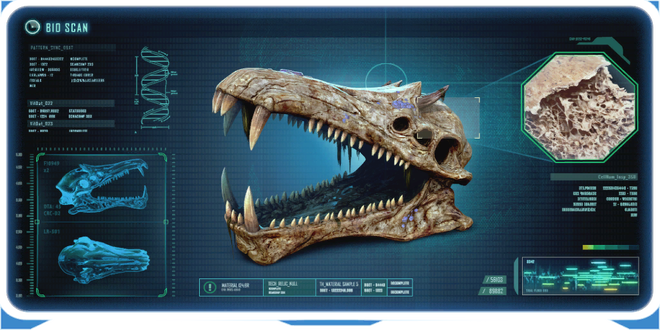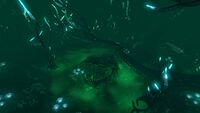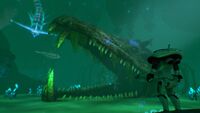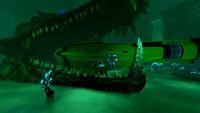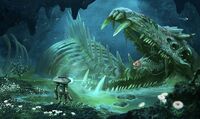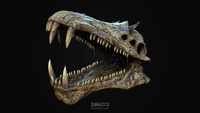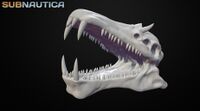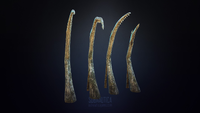Gargantuan Fossil: Difference between revisions
FISHES2000 (talk | contribs) No edit summary Tags: Reverted Visual edit |
Terranhawk (talk | contribs) m (Reverted edits by Thisnameiscool29476 (talk) to last revision by VeeCaecus) Tag: Rollback |
||
| (8 intermediate revisions by 4 users not shown) | |||
| Line 10: | Line 10: | ||
** [[Lost River| Ghost Forest]] |
** [[Lost River| Ghost Forest]] |
||
}} |
}} |
||
The '''Gargantuan Fossil''' is an enormous |
The '''Gargantuan Fossil''' is an enormous, ancient fossil, approximately three million years old, found in the [[Lost River|Bone Fields]]. The skeleton belonged to an eel-like [[Leviathan Class Organisms|Leviathan Class]] super-predator dwarfing both the [[Sea Dragon Leviathan]] and [[Sea Emperor Leviathan]], despite only being around one third of the whole skeleton. The remains consist of a huge, draconic skull and sixteen pairs of huge ribs. The skeleton is covered in [[flora]] and [[coral]]. The skull is so large that a [[Cyclops]] can fit inside its jaws. |
||
The ribs are identical in structure, though far smaller ones can be seen in the entrance to the Lost River Junction, whilst a much smaller but otherwise identical skull can be found in the Ghost Forest, presumably from a juvenile specimen of the species. |
|||
The Precursors were also studying these remains, as evidenced by small, angular indentations on the ribcage. These samples were probably studied at the [[Lost River Laboratory Cache]], as this was the main site in which Leviathan class bone samples are found. |
The Precursors were also studying these remains, as evidenced by small, angular indentations on the ribcage. These samples were probably studied at the [[Lost River Laboratory Cache]], as this was the main site in which Leviathan class bone samples are found. |
||
| Line 19: | Line 19: | ||
The skeleton is enormous. The skull by itself is just under 100 meters in length, almost as long as the entire body of a Sea Dragon Leviathan. The two lower front teeth measure at 11.4 meters in height and the two upper teeth at 10.3 meters. The largest of the structures resembling eye sockets measure 9.7 meters in diameter. |
The skeleton is enormous. The skull by itself is just under 100 meters in length, almost as long as the entire body of a Sea Dragon Leviathan. The two lower front teeth measure at 11.4 meters in height and the two upper teeth at 10.3 meters. The largest of the structures resembling eye sockets measure 9.7 meters in diameter. |
||
The skeleton that remains measures at 402 meters in length, and with the PDA estimating that it is only one third of the complete specimen, the creature would likely have measured between |
The skeleton that remains measures at 402 meters in length, and with the PDA estimating that it is only one third of the complete specimen, the creature would likely have measured between 1,100 and 1,300 meters long. |
||
== In Life == |
== In Life == |
||
When this creature still roamed the planet, the |
When this creature still roamed the planet, the immense size of its body would likely have prevented it from surviving within the crater, as it is more than half the 2 kilometer diameter of the entire structure. As little is known of life outside of the crater, it is not clear what it could have preyed on or if the prey species still exists: the most likely living species would be the [[Reefback Leviathan]]. |
||
These creatures were likely very long-lived with a low reproductive rate, as a large population of them would very quickly outpace the ability of prey species to repopulate. |
|||
== |
==Data Bank Entry== |
||
{| class="article-table" style="width:100%; border:0; border-spacing:0" |
{| class="article-table" style="width:100%; border:0; border-spacing:0" |
||
|- |
|- |
||
! style="width: 100%; text-align:center" | |
! style="width: 100%; text-align:center" |[[File:GargantuanFossilEncy.png|660px]] |
||
|- |
|- |
||
| style="text-align:left; font-size:12px" | |
| style="text-align:left; font-size:12px" |The fossilized remains of an extinct super predator. Its sheer size would have prohibited it from entering such an enclosed space, suggesting the geography of the planet has shifted around it over time. A true apex predator. |
||
- Dated at approximately three million years old<br/> |
- Dated at approximately three million years old<br /> |
||
- Rib cage measurements suggest the creature was eel-like in structure<br/> |
- Rib cage measurements suggest the creature was eel-like in structure<br /> |
||
- Calculations suggest this is only the front third of the specimen<br/> |
- Calculations suggest this is only the front third of the specimen<br /> |
||
- The remains now support a vibrant microcosm of life |
- The remains now support a vibrant microcosm of life |
||
| Line 41: | Line 41: | ||
|} |
|} |
||
== |
==Gallery== |
||
<tabber> |
<tabber> |
||
Screenshots= |
Screenshots= |
||
| Line 48: | Line 48: | ||
GF2.jpg|The miniature version of the gargantuan skull found within the Ghost Forest. |
GF2.jpg|The miniature version of the gargantuan skull found within the Ghost Forest. |
||
Skeleton with Ghost leviathan and prawn suit.jpg|Head with prawn suit |
Skeleton with Ghost leviathan and prawn suit.jpg|Head with prawn suit |
||
Subnautica 2020-09-14 02-23-59.png|The Gargantuan Fossil - Player, Seamoth, |
Subnautica 2020-09-14 02-23-59.png|The Gargantuan Fossil - Player, Seamoth, Prawn Suit, and Cyclops for scale |
||
Subnautica 2020-09-14 02-24-22.png|The Gargantuan Fossil - Player, Seamoth, |
Subnautica 2020-09-14 02-24-22.png|The Gargantuan Fossil - Player, Seamoth, Prawn Suit, and Cyclops for scale (closer up) |
||
</gallery> |
</gallery> |
||
|-| |
|-| |
||
| Line 68: | Line 68: | ||
Size Comparisons= |
Size Comparisons= |
||
<gallery> |
<gallery> |
||
Skull.jpg|Gargangtuan skull size compared to Ryley, Seamoth, Prawn Suit and Cyclops |
Skull.jpg|Gargangtuan skull size compared to Ryley, the Seamoth, Prawn Suit and Cyclops |
||
Skeleton.jpg|Entire fossil compared to Ryley, Seamoth, Prawn Suit and Cyclops |
Skeleton.jpg|Entire fossil compared to Ryley, the Seamoth, Prawn Suit and Cyclops |
||
Skeleton whole.jpg|Theoretical whole skeleton length |
Skeleton whole.jpg|Theoretical whole skeleton length |
||
2018-04-01 - 17,20,32.png|In game models size scale - Wasabi one, Seamoth, Prawn Suit, Cyclops, Gargantuan skull, in game skeleton and theoretical whole size |
2018-04-01 - 17,20,32.png|In game models size scale - Wasabi one, Seamoth, Prawn Suit, Cyclops, Gargantuan skull, in game skeleton and theoretical whole size |
||
Latest revision as of 12:51, 30 January 2025

|
Read at own risk This article contains unmarked spoilers. Players new to the game would want to avoid or be cautious toward this article. |
<infobox layout="stacked">
<title source="title" style="font-weight:bold; text-align:center;"> <default>Gargantuan Fossil</default> </title> <image source="image">
</image> <label>Age</label> <label>Status</label> <label>Biome</label> <label>Length</label> <label>Coordinates</label> <label>GoTo</label> <label>Debug Spawn</label> </infobox> The Gargantuan Fossil is an enormous, ancient fossil, approximately three million years old, found in the Bone Fields. The skeleton belonged to an eel-like Leviathan Class super-predator dwarfing both the Sea Dragon Leviathan and Sea Emperor Leviathan, despite only being around one third of the whole skeleton. The remains consist of a huge, draconic skull and sixteen pairs of huge ribs. The skeleton is covered in flora and coral. The skull is so large that a Cyclops can fit inside its jaws. The ribs are identical in structure, though far smaller ones can be seen in the entrance to the Lost River Junction, whilst a much smaller but otherwise identical skull can be found in the Ghost Forest, presumably from a juvenile specimen of the species. The Precursors were also studying these remains, as evidenced by small, angular indentations on the ribcage. These samples were probably studied at the Lost River Laboratory Cache, as this was the main site in which Leviathan class bone samples are found.
Size
The skeleton is enormous. The skull by itself is just under 100 meters in length, almost as long as the entire body of a Sea Dragon Leviathan. The two lower front teeth measure at 11.4 meters in height and the two upper teeth at 10.3 meters. The largest of the structures resembling eye sockets measure 9.7 meters in diameter.
The skeleton that remains measures at 402 meters in length, and with the PDA estimating that it is only one third of the complete specimen, the creature would likely have measured between 1,100 and 1,300 meters long.
In Life
When this creature still roamed the planet, the immense size of its body would likely have prevented it from surviving within the crater, as it is more than half the 2 kilometer diameter of the entire structure. As little is known of life outside of the crater, it is not clear what it could have preyed on or if the prey species still exists: the most likely living species would be the Reefback Leviathan.
These creatures were likely very long-lived with a low reproductive rate, as a large population of them would very quickly outpace the ability of prey species to repopulate.
Data Bank Entry
Gallery
<tabber> Screenshots=
|-| Concept Art=
|-| Models=
Model from Sketchfab
Highpoly model from Sketchfab
Older WIP model from Sketchfab
Models of ribs from Sketchfab
|-| Size Comparisons=
</tabber>
Lua error in package.lua at line 80: module 'Dev:Navbox' not found.

